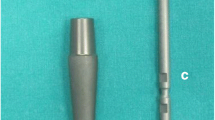Abstract
Purpose
A total of 894 hips were evaluated to describe the survivorship of Exeter cemented femoral stems and report the outcomes and complications of our ‘Exeter- era’, and there is no study from Central or Eastern Europe demonstrating similar results.
Methods
Between January 2000 and December 2009, a total of 894 hips were included who underwent Exeter universal and V40 femoral stems with a mean follow up of 13 years. Cemented Exeter low profile polyethylene cups were used in 889 patients (99.4%) cups. Harris hip score (HHS) was used and statistical outcome measures were calculated with revision as an endpoint for aseptic loosening of the stem, aseptic loosening of any component, all-cause revision of the stem, and all-cause revision of the hip.
Results
A total of 103 patients died and 129 (14.4%) operated hips were lost to follow-up before ten years. Out of the 662, ten stems (1.5%) were revised for aseptic loosening. Aseptic loosening of any component was the reason for revision in 43 cases (6.5%), consisting of 40 cup revisions and ten stem exchanges. Periprosthetic fracture occurred in 17 cases (1.9%) Periprosthetic joint infection occurred in 18 cases (2.01%). Three cups were exchanged for recurrent dislocation, and two stems had broken.
Conclusion
Exeter hip system has provided reproducible results across different centres worldwide, as it did in our series. Thorough surgical and cementing technique is of utmost importance for achieving these results. The cup is the weak point of the system and use of a hybrid system is worth considering.



Similar content being viewed by others
Data availability
Not applicable.
Code availability
Not applicable.
References
Troelsen A, Malchau E, Sillesen N et al (2013) A review of current fixation uses and registry outcomes in total hip arthroplasty: the uncemented paradox. Clin Orthop 471(7):2052–2059. https://doi.org/10.1007/s11999-013-2941-7
Berry DJ, Harmsen WS, Cabanela ME et al (2002) Twenty-fiveyear survivorship of two thousand consecutiveprimary Charnley total hip replacements: factors affecting survivorship of acetabular and femoral components. J Bone JtSurg-Am 84(2):171–177. https://doi.org/10.2106/00004623-200202000-00002
Callaghan JJ, Bracha P, Liu SS et al (2009) Survivorship of a Charnley total hip arthroplasty: a concise follow-up, at aminimum of thirty-five years, of previous reports. J Bone JtSurg 91(11):2617–2621. https://doi.org/10.2106/JBJS.H.01201
Santori N, Falez F, Potestio D, Santori FS (2019) Fourteen-year experience with short cemented stems in total hip replacement. Int Orthop 43(1):55–61. https://doi.org/10.1007/00264-018-4205-3
Mulroy R, Harris W (1990) The effect of improved cementing techniques on component loosening in total hip replacement. An 11-year radiographic review. J Bone Joint Surg Br 72-B(5): 757–760. https://doi.org/10.1302/0301-620X.72B5.2211749
Cassar-Gheiti AJ, McColgan R, Kelly M et al (2020) Current concepts and outcomes in cemented femoral stem design and cementation techniques: the argument for a new classification system. EFORT Open Rev 5(4):241–252. https://doi.org/10.1302/2058-5241.5.190034
Ritter J, Hubert J, Kniep I, Beil FT, Rolvien T, Puschel K (2022) Pulmonary cement embolism is frequently observed but not a contributing factor for death in patients with cemented total hip and knee arthroplasty: a post-mortem study. Int Orthop 46(6):1225–1232. https://doi.org/10.1007/00264-022-05381-6
Mahon J, McCarthy CJ, Sheridan GA et al (2020) Outcomes of the exeter v40 cemented femoral stem at a minimum of ten years in a non-designer centre. Bone Jt Open 1(12):743–748. https://doi.org/10.1302/2633-1462.112.BJO-2020-0163.R1
Westerman RW, Whitehouse SL, Hubble MJW et al (2018) The exeter v40 cemented femoral component at a minimum 10 year follow-up: the first 540 cases. Bone Jt J 100-B(8): 1002–1009. https://doi.org/10.1302/0301-620X.100B8.BJJ-2017-1535.R1
Ling RSM, Charity J, Lee AJC et al (2009) The long-term results of the original Exeter polished cemented femoral component: a follow-up report. J Arthroplasty 24(4):511–517. https://doi.org/10.1016/j.arth.2009.02.002
Fowler JL, Gie GA, Lee AJ et al (1970) Experience with the Exeter total hip replacement since 1970. Orthop Clin North Am 19(3):477–489
Pai VS (2002) A modified direct lateral approach in total hip arthroplasty. J Orthop Surg 10(1):35–39. https://doi.org/10.1177/230949900201000107
Hardinge K (1982) The direct lateral approach to the hip. J Bone Joint Surg 64B:17. https://doi.org/10.1302/0301-620X.64B1.7068713
Williams HDW, Browne G, Gie GA et al (2002) The exeter universal cemented femoral component at 8 to 12 years: a study of the first 325 hips. J Bone Joint Surg Br 84-B(3): 324–334. https://doi.org/10.1302/0301-620x.84b3.12261
Carrington NC, Sierra RJ, Gie GA et al (2009) The exeter universal cemented femoral component at 15 to 17 years: an update on the first 325 hips. J Bone Joint Surg Br 91-B(6): 730–737. https://doi.org/10.1302/0301-620X.91B6.21627
Petheram TG, Whitehouse SL, Kazi HA et al (2016) The Exeter universal cemented femoral stem at 20 to 25 years: a report of 382 hips. Bone Joint J 98-B(11):1441–1449. https://doi.org/10.1302/0301-620X.98B11.37668
Hook S, Moulder E, Yates PJ et al (2006) The exeteruniversal stem: a minimum ten-year review from an independent centre. J Bone Joint Surg Br 88-B(12):1584–1590. https://doi.org/10.1302/0301-620X.88B12.18345
Young L, Duckett S, Dunn A (2009) The use of the cemented exeter universal femoral stem in a district general hospital: a minimum ten-year follow-up. J Bone Joint Surg Br 91-B(2):170–175. https://doi.org/10.1302/0301-620X.91B2.20473
Mäkelä K, Eskelinen A, Pulkkinen P, Paavolainen P, Remes V (2008) Cemented total hip replacement for primary osteoarthritis in patients aged 55 years or older: results of the 12 most common cemented implants followed for 25 years in the Finnish Arthroplasty Register. J Bone Joint Surg Br 90(12):1562–1569. https://doi.org/10.1302/0301-620X.90B12.21151
Chiu KH, Shen WY, Cheung KW et al (2005) Primary exeter total hip arthroplasty in patients with small femurs. J Arthroplasty 20(3):275–281. https://doi.org/10.1016/j.arth.2004.01.014
Maggs JL, Smeatham A, Whitehouse SL et al (2016) The Exeter contemporary flanged cemented acetabular component in primary total hip arthroplasty. Bone Joint J 98-B(3):307–312. https://doi.org/10.1302/0301-620X.98B3.35901
Boyle AB, Zhu M, Frampton C et al (2022) Comparing uncemented, hybrid and cemented primary total hip arthroplasty in young patients, a New Zealand Joint Registry study. Arch Orthop Trauma Surg 142(9):2371–2380. https://doi.org/10.1007/s00402-021-04085-7
Gwynne-Jones DP and Gray AR (2020) Cemented or uncemented acetabular fixation in combination with the exeter universal cemented stem: long-term survival to 18 years. Bone Joint J 102-B(4): 414–422. https://doi.org/10.1302/0301-620X.102B4.BJJ-2019-0656.R1
Farhan-Alanie OMH, Hrycaiczuk A, Tinning C et al (2022) Alumina ceramic-on-ceramic hybrid total hip arthroplasty. A median of 15 years follow-up. Eur J Orthop Surg Traumatol 32(6):1127–1136. https://doi.org/10.1007/s00590-021-03087-w
Keeling P, Howell JR, Kassam AAM et al (2020) Long-term survival of the cemented exeter universal stem in patients 50 years and younger: an update on 130 hips. J Arthroplasty 35(4):1042–1047. https://doi.org/10.1016/j.arth.2019.11.009
Schmitz MWJL, Bronsema E, de Kam DCJ, et al. (2017) Results of the cemented exeter femoral component in patients under the age of 40: an update at ten to 20 years’ follow-up. Bone Jt J 99-B(2): 192–198. https://doi.org/10.1302/0301-620X.99B2.38045
Lewthwaite SC, Squires B, Gie GA et al (2008) The exeter ™ universal hip in patients 50 years or younger at 10–17 years’ follow up. Clin Orthop 466(2):324–331. https://doi.org/10.1007/s11999-007-0049-7
Chatziagorou G, Lindahl H, Kärrholm J (2019) The design of the cemented stem influences the risk of Vancouver type B fractures, but not of type C: an analysis of 82,837 Lubinus SPII and Exeter Polished stems. Acta Orthop 90(2):135–142. https://doi.org/10.1080/17453674.2019.1574387
Pakarinen OA, Neuvonen PS, Lainiala OS et al (2021) Periprosthetic femoral fracture is a leading cause of early revision with taper-slip stems in primary total hip arthroplasty: an analysis of 2765 total hip arthroplasties from a high-volume hospital. J Arthroplasty 36(11):3703-3708.e2. https://doi.org/10.1016/j.arth.2021.06.022
Gausden EB, Abdel MP, Mabry TM et al (2021) Midterm results of primary Exeter cemented stem in a select patient population. J Bone Joint Surg Am 103(19):1826–1833. https://doi.org/10.2106/JBJS.20.01829
Kristensen TB, Dybvik E, Furnes O et al (2018) More reoperations for periprosthetic fracture after cemented hemiarthroplasty with polished taper-slip stems than after anatomical and straight stems in the treatment of hip fractures: a study from the Norwegian Hip Fracture Register 2005 to 2016. Bone Joint J 100-B(12):1565–1571. https://doi.org/10.1302/0301-620X.100B12.BJJ-2018-0262.R1
Powell-Bowns MFR, Oag E, Martin D et al (2022) Vancouver B and C periprosthetic fractures around the cemented Exeter stem: sex is associate with fracture pattern. Arch Orthop Trauma Surg 142(11):3221–3228. https://doi.org/10.1007/s00402-02104113-6
Thompson JW, Corbett J, Bye D et al (2021) Analysis of the Exeter V40 femoral stem prosthesis fracture: systematic review and single centre case series. Bone Joint Open 2(6):443–456. https://doi.org/10.1302/2633-1462.26.BJO-2021-0025.R1
Greenwald AS, Narten NC, Wilde AH (1978) Points in the technique of recementing in the revision of an implant arthroplasty. J Bone Joint Surg Br 60(1):107–110. https://doi.org/10.1302/0301-620X.60B1.627570
Author information
Authors and Affiliations
Contributions
All authors contributed to the study conception and design. Material preparation, data collection and analysis was performed by Jánvári Kristóf, László Szabó, and László Bucsi. The first draft of the manuscript was written by Jánvári Kristóf, Devanshu Gupta, and Ákos Zahár, and all authors commented on previous versions of the manuscript. All authors read and approved the final manuscript.
Corresponding author
Ethics declarations
Consent for publication
The authors affirm that all the study subjects consented to their data being used for publication.
Informed consent
Informed consent was obtained from all individual participants included in the study.
Conflict of interest
The authors declare no competing interests.
Additional information
Publisher's Note
Springer Nature remains neutral with regard to jurisdictional claims in published maps and institutional affiliations.
Rights and permissions
Springer Nature or its licensor (e.g. a society or other partner) holds exclusive rights to this article under a publishing agreement with the author(s) or other rightsholder(s); author self-archiving of the accepted manuscript version of this article is solely governed by the terms of such publishing agreement and applicable law.
About this article
Cite this article
Kristóf, J., Gupta, D., Szabó, L. et al. Outcomes of Exeter cemented total hip arthroplasty in a county hospital: survivorship of eight hundred and ninety four hips with a minimum ten-year follow up. International Orthopaedics (SICOT) 48, 729–735 (2024). https://doi.org/10.1007/s00264-023-06026-y
Received:
Accepted:
Published:
Issue Date:
DOI: https://doi.org/10.1007/s00264-023-06026-y




